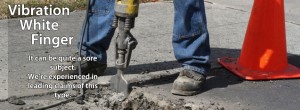In late March 2018, the Health and Safety Executive (HSE) issued two press releases regarding the successful prosecution of two employers who had exposed employees to excessive vibration in their day to day work over a prolonged period, resulting in Hand Arm Vibration Syndrome (HAVS). In this article, we will explain what happened in these cases, the damage that vibration can cause to the human body, and the long-term impacts.
What is HAVS?
HAVS occurs when due to prolonged exposure to vibration (normally for ten years or more), symptoms including loss of sensation (numbness), tingling, pins and needles, pain in the fingers, eventuate. Often the fingers turn white due to the loss of blood flow to the affected area. In some cases, the patient can suffer Raynaud’s phenomenon, often due to cold weather, whereby the finger turns white, then bluish due to the lack of oxygen available in the narrowed blood vessels, and in the last stage, the fingers can turn bright red, when the blood vessels dilate, causing very uncomfortable throbbing, tingling, and pain . It is thought that the repeated vibration causes microscopic damage to the nerves and blood vessels in the fingers, which over the years leads to a permanent injury.
pain in the fingers, eventuate. Often the fingers turn white due to the loss of blood flow to the affected area. In some cases, the patient can suffer Raynaud’s phenomenon, often due to cold weather, whereby the finger turns white, then bluish due to the lack of oxygen available in the narrowed blood vessels, and in the last stage, the fingers can turn bright red, when the blood vessels dilate, causing very uncomfortable throbbing, tingling, and pain . It is thought that the repeated vibration causes microscopic damage to the nerves and blood vessels in the fingers, which over the years leads to a permanent injury.
Depending on the level of damage, normal functioning may recover once exposure to vibration equipment ceases, however, the symptoms may persist.
Two cases with common causes
The two cases related to separate businesses, both in South Wales, only 13 miles apart. In the first case, Design and Supply Limited in Merthyr Tydfil were accused of exposing an employee to vibration from the use of handheld pneumatic buffing and sanding tools spanning a period of 15 years. The employee was found to have sustained
HAVS. When the circumstances were investigated by HSE they found a number of failings:
- Lack of a safe system of work to control the vibration
- No risk assessment had been carried out for the use of power tools
- Insufficient information, training, and supervision had been provided to employees to ensure they were safe from HAVS
- There was no suitable health surveillance system to detect HAVS at an early stage
Design and Supply Limited pleaded guilty to breaching Section 2(1) of the Health and Safety at Work Act 1974. They were ordered to pay a fine £50,000 and costs.
In the second case, housing association Tai Calon Community Housing Limited, near Newport, was prosecuted for also exposing employees to HAVS over many years. The company had introduced a health surveillance system in 2015 (something that Design and Supply had not done), which picked up a number of confirmed cases of the vibration caused health condition. Despite the surveillance system being in place since 2015, this was still found to be an issue in the investigation, in addition to inadequate risk assessment, training, instruction, and information. The company were fined £30,000 plus costs.
Control of Vibration at Work Regulations 2005
The Control of Vibration at Work Regulations 2005 were created under the Health and Safety at Work etc. Act 1974 to place a duty on employers to reduce the risk to their employees of exposure to vibration. The legislation was introduced to reduce not only HAVS, but also whole body vibration disorders (WBV), and defines how much vibration an employee can be exposed to legally in a working day, factors to be considered when conducting a risk assessment, and the requirements for health surveillance.
How can you avoid HAVS as an employee?
It is your employer’s duty to make sure that you are informed of the dangers of using vibrating workplace machinery, that your levels of exposure are controlled, and that the equipment used is well maintained. It is also good practice to ensure that as a user of such machinery, you:
- Hold the tool as loosely as possible, and in varying positions
- Make sure you take regular breaks when using the vibrating equipment
- Report any concerns you have with your health and the equipment as soon as you notice any problems
- Use the correct tool for the job
- Keep warm, including your hands, to ensure blood flow to your extremities
- If you have not been trained or provided with adequate supervision, instructions or information, ask your supervisor before proceeding
Claiming compensation for HAVS
The damage and symptoms from HAVS can range considerably. After prolonged exposure to occupational vibration which has not been adequately managed, employees may be left with permanent disability, which in turn may mean they are unable to continue in the occupation for which they are skilled and experienced. HAVS can also lead to sleep problems, and therefore ongoing fatigue and related health outcomes.
If you have been diagnosed with HAVS, at any stage of the condition, you may be able to seek compensation if it can be proven that your employer failed to protect you. If they did not train you properly, give you sufficient information and instruction, check your health on a regular basis, supervise you, provide the correct equipment for the tasks you were undertaking, or maintain the tools in question, they may have been in breach of their legal duties, meaning that you may be eligible for financial compensation. The compensation you receive will cover the pain and suffering you have endured, and any financial losses and expenses, including actual or expected loss of earnings.
At Russell Worth Solicitors we specialise in personal injury claims. If you have suffered a workplace injury and would like a free claim assessment, please call us now on 0800 028 2060 or complete our Online Claim Assessment.

